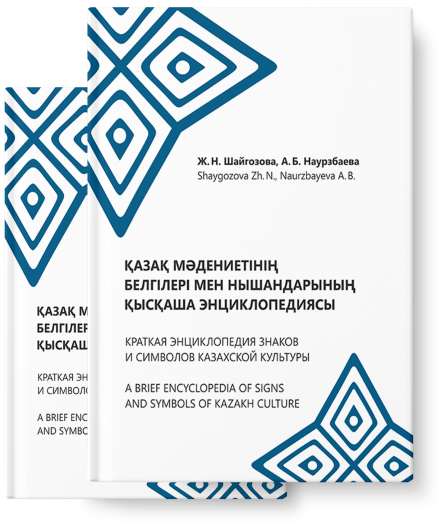
A short encyclopedia of
Signs and symbols of
Kazakh culture

In the symbolic representations of ancient cultures, the wind is a manifestation of the supernatural, and various functions are attributed to it. In some cultures it is depicted in association with certain deities. In ancient Greece, for example, the north wind Borey was depicted with legs in the shape of a snake and sometimes with winged feet. The ancient Chinese worshipped the wind (feng) as a bird god, and they call the particular “science” of harmonizing the surrounding space “feng shui” (wind-water). Some Turkic peoples, e.g. Karachai and Balkar, had a belief in gods in which the father of winds was considered Goriy or Geri-Goriy or Zhelle-Atasy Goriy and the mother as Zhel-Anasy Kimikki. Among the Kazakhs of the Syr-Darya Valley, the owner of the wind was believed to be Zhalanash-ata (literally “naked”), and his lord was considered Zhalanash-ata. Some experts, citing Chinese sources, point to the existence of the ancient Turkic temple wind, which was called “dispersing clouds.”
The understanding of the wind as a sacral force in Turkic culture had at least two meanings: the source of the human spirit and the cause of many evils, diseases, i.e. In the Kazakh folk tale “Zharty-Tostik” the origin of the wind is associated with the wings of the sacred bird Samruk, which nests on the world tree – Baiterek. The reconstruction of the Old Turkic yel (zhel) S. Kondybay [11] establishes a connection with the Aruaks (ancestral spirits) by tracing the derivation of zhel – “zheleu” (eleu) to their functional tasks – zhelep-zhebep zhüru (guard, watchman). The researcher also notes that the word “zhel” has a negative connotation associated with demonic creatures: “Shaitan”, “jinn-Peri”.
S.K. Akhmetova notes that among Siberian Kazakhs there is still a belief in shaitan roads – dust whirls or simply strong winds that can bring illness to people. People who are sick in such cases say “zhyn zholina tüsken” – have on the road shaitan, evil spirit” [1, p. 195]. Wind is yel and is represented in the Hakas mythology by a demonic being, an evil spirit.

The ancient Turks believed that the wind was directly related to Tengri himself, and classified him as a secondary deity. Information on the divine origin of the wind with reference to the Manichaean text “Kefalaya” can be found in Yu.A. Zuev: five elements-warrior (Turk. oylan) light (the god of light wind tintura tengri, the god of living wind jel tengri, the god of living light jaruq tengri, the god of water suv tengri, the god of fire ot tengri) under the leadership of the light-bearing primordial man in the struggle with the elements of anti-simility [8, p. 140]. The divine hypostasis of wind in the representations of Turks manifests itself, for example, in the traditional culture of modern Azerbaijanis in the figure of the mythical elder Yel Baba (Grandfather Wind) or Yel Dede (Father Wind).
According to experts, Kazakhs have more than seventy names for the wind, the semantics of which are diverse and range from expressions of joy to suffering. Among the first are the light summer winds – Samal (light mountain breeze), Ystyq Zhel (hot summer wind) etc. The wind that is considered the most insidious is named “Qara Qanshyq” – “black bitch, black wolf”. According to the well-known cultural scientist Z. Naurzbayeva [14], the Kazakhs meant by it a sultry summer wind that burns herbs and crops, a wind that condemns livestock and people to starvation. The autumn wind “qara bass zhel” (“black-headed wind”) was considered a harbinger of winter, cold and hard times. The cold April wind, which usually blows at the end of the month, the Kazakhs call “tobylgy zharğan” (letters. “split meadow”). In these days the first green appears in the steppe and the grace period begins.
The symbolism of the wind was projected among Turkic peoples to the characterization of people and animals: fast horse were usually given epithets. The wind represented masculinity, the cosmic element and spiritual essence.

